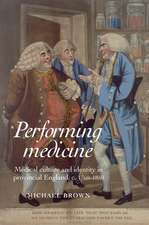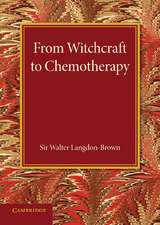Medicine, the Penal System and Sexual Crimes in England, 1919-1960s: Diagnosing Deviance
Autor Janet Westonen Limba Engleză Paperback – 18 sep 2019
| Toate formatele și edițiile | Preț | Express |
|---|---|---|
| Paperback (1) | 230.03 lei 43-57 zile | |
| Bloomsbury Publishing – 18 sep 2019 | 230.03 lei 43-57 zile | |
| Hardback (1) | 789.74 lei 43-57 zile | |
| Bloomsbury Publishing – 13 dec 2017 | 789.74 lei 43-57 zile |
Preț: 230.03 lei
Preț vechi: 296.69 lei
-22% Nou
Puncte Express: 345
Preț estimativ în valută:
44.02€ • 46.08$ • 36.42£
44.02€ • 46.08$ • 36.42£
Carte tipărită la comandă
Livrare economică 07-21 aprilie
Preluare comenzi: 021 569.72.76
Specificații
ISBN-13: 9781350118911
ISBN-10: 1350118915
Pagini: 216
Dimensiuni: 153 x 234 x 18 mm
Greutate: 0.31 kg
Editura: Bloomsbury Publishing
Colecția Bloomsbury Academic
Locul publicării:London, United Kingdom
ISBN-10: 1350118915
Pagini: 216
Dimensiuni: 153 x 234 x 18 mm
Greutate: 0.31 kg
Editura: Bloomsbury Publishing
Colecția Bloomsbury Academic
Locul publicării:London, United Kingdom
Caracteristici
Makes use of under-utilized records, including medical and criminological texts, trial proceedings, government reports, newspapers, and autobiographies and memoirs
Notă biografică
Janet Weston is Research Fellow at the Centre for History in Public Health, London School of Hygiene and Tropical Medicine, UK.
Cuprins
1. Introduction2. The 'Curative Treatment of Crime'3. Normal and Abnormal4. Causes and Treatments5. Doctors in the Dock6. Who Could be Cured?7. Conclusion
Recenzii
As Weston points out, sources are scarce on the doctors, judges, and rehabilitation staff involved in sentencing and treating offenders, and records are essentially nonexistent when it comes to the deviants themselves and, especially, their victims. As a result, the sources are largely bureaucratic in nature. However, the author is adept at interpreting them to show nuanced trends in the medico-legal definition of deviance. Summing Up: Recommended. Graduate students/faculty/professionals.
An important corrective to existing scholarship on the history of psychiatry and crime that focuses primarily on categorizing sexual difference or the insanity defense. Seeing the history from the perspective of rehabilitating sex offenders gives us the chance to consider more thoroughly how and why physicians regarded some sex offenses as pathological but others not, further revealing how deeply rooted ideas about gender roles shaped medical thought.
Using a range of material, including medical and criminological texts, trial proceedings, government reports, newspapers, and autobiographies and memoirs, Janet Weston offers powerful insights into changing medico-legal practices and attitudes towards sex and health.
Weston's intriguing book brings a much-needed nuanced analysis to a topic - exploring the prospects for rehabilitating sexual offenders - shrouded in controversy and misconceptions. Weston draws on insights from the history of sexuality, the history of mental health, and the history of prisons to show that efforts in 20th century England, while not uniform, nevertheless provided clinicians there with the opportunity to expand their reach within the criminal justice system. Historians of medicine, crime, and sexuality will all want to consult this insightful study.
For too long historians of psychiatry have focused separately on topics such as the construction of sexological categories, the spread of psychoanalysis, the uses of the M'Naghten Rules. Finally, Janet Weston has moved us on to a history of forensic sexual psychiatry that draws all of these fields together. Her book is meticulously researched and persuasive in its arguments about the formation of sexual criminals - homosexuals, sadists, exhibitionists, pedophiles - their incarceration and treatments. This ground-breaking history tells how the State enters the lives and minds of individuals whose sexual desires are outside of accepted norms.
An important corrective to existing scholarship on the history of psychiatry and crime that focuses primarily on categorizing sexual difference or the insanity defense. Seeing the history from the perspective of rehabilitating sex offenders gives us the chance to consider more thoroughly how and why physicians regarded some sex offenses as pathological but others not, further revealing how deeply rooted ideas about gender roles shaped medical thought.
Using a range of material, including medical and criminological texts, trial proceedings, government reports, newspapers, and autobiographies and memoirs, Janet Weston offers powerful insights into changing medico-legal practices and attitudes towards sex and health.
Weston's intriguing book brings a much-needed nuanced analysis to a topic - exploring the prospects for rehabilitating sexual offenders - shrouded in controversy and misconceptions. Weston draws on insights from the history of sexuality, the history of mental health, and the history of prisons to show that efforts in 20th century England, while not uniform, nevertheless provided clinicians there with the opportunity to expand their reach within the criminal justice system. Historians of medicine, crime, and sexuality will all want to consult this insightful study.
For too long historians of psychiatry have focused separately on topics such as the construction of sexological categories, the spread of psychoanalysis, the uses of the M'Naghten Rules. Finally, Janet Weston has moved us on to a history of forensic sexual psychiatry that draws all of these fields together. Her book is meticulously researched and persuasive in its arguments about the formation of sexual criminals - homosexuals, sadists, exhibitionists, pedophiles - their incarceration and treatments. This ground-breaking history tells how the State enters the lives and minds of individuals whose sexual desires are outside of accepted norms.
























